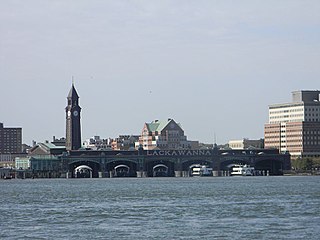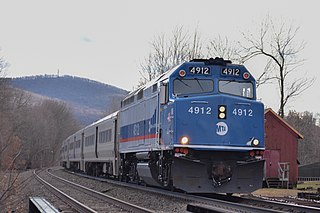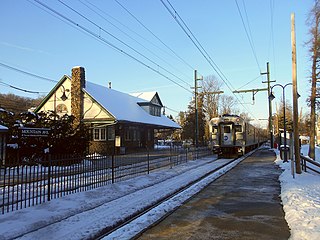
Poughkeepsie station is a Metro-North Railroad and Amtrak stop serving the city of Poughkeepsie, New York. The station is the northern terminus of Metro-North's Hudson Line, and an intermediate stop for Amtrak's several Empire Corridor trains.

The Main Line is a commuter rail line owned and operated by New Jersey Transit running from Suffern, New York to Hoboken, New Jersey, in the United States. It runs daily commuter service and was once the north–south main line of the Erie Railroad. It is colored yellow on NJ Transit system maps, and its symbol is a water wheel.

Hoboken Terminal is a commuter-oriented intermodal passenger station in Hoboken, Hudson County, New Jersey. One of the New York metropolitan area's major transportation hubs, it is served by eight NJ Transit (NJT) commuter rail lines, an NJ Transit event shuttle to Meadowlands Sports Complex, one Metro-North Railroad line, various NJT buses and private bus lines, the Hudson–Bergen Light Rail, the Port Authority Trans Hudson (PATH) rapid transit system, and NY Waterway-operated ferries.

Chappaqua station is a commuter rail stop on the Metro-North Railroad's Harlem Line, located in Chappaqua, New York, United States, within the town of New Castle.

The Port Jervis Line is a predominantly single-track commuter rail line running between Suffern and Port Jervis, in the U.S. state of New York. At Suffern, the line continues south into New Jersey on NJ Transit's Main Line. The line is operated by NJ Transit Rail Operations under a contract with Metro-North Railroad (MNRR).

Newark Broad Street station is a New Jersey Transit commuter rail and light rail station at 25 University Avenue in Newark, New Jersey. Built in 1903, the station's historic architecture includes an elegant clock tower and a brick and stone façade on the station's main building. In June 1984, the station was added to the National Register of Historic Places in recognition of its historical significance.

Mountain Avenue is an active commuter railroad station in the township of Montclair, Essex County, New Jersey. Serving trains of NJ Transit's Montclair-Boonton Line, Mountain Avenue is one of six stops in the municipality. The next station to the south/east is Upper Montclair. The next station to the north/west is Montclair Heights. Mountain Avenue contains two low-level side platforms. The station depot built by the Erie Railroad stands on the inbound platform, offering a waiting room for commuters. Part of the depot is also leased by the municipality for a residence.

Sloatsburg station is a commuter rail stop owned by Metro-North Railroad serving trains on the Port Jervis Line, located in the village of Sloatsburg, New York at the intersection of Municipal Plaza and Mills Street.

The Port Jervis station is a disused train station at the corner of Jersey Avenue and Fowler Street in Port Jervis, New York. It was built in 1892 as a passenger station for the Erie Railroad by Grattan & Jennings in the Queen Anne style. For years it was the busiest passenger station on the railroad's Delaware Branch because Port Jervis is along the Delaware River near the tripoint of New York, New Jersey, and Pennsylvania. The long-distance passenger trains Erie Limited and the Lake Cities between Chicago and Hoboken served this station.

Waldwick is a commuter rail station operated by New Jersey Transit in the borough of Waldwick, Bergen County, New Jersey, United States.

Ampere, formerly known as The Crescent, is a defunct stop on New Jersey Transit's Montclair-Boonton Line in the city of East Orange, Essex County, New Jersey, United States. A station was first built there in 1890 to service to new Crocker Wheeler plant in the district. The stop was named in honor of André-Marie Ampère, a pioneer in electrodynamics and reconstructed as a new Renaissance Revival station in 1908. Ampere was the second stop on the branch west of Newark Broad Street Station until 1984, when the Roseville Avenue station was closed. In June of that year, the station, along with 42 others, was entered into the National Register of Historic Places. In 1986, after continuous deterioration, New Jersey Transit demolished the westbound shelter built in 1921. The agency discontinued rail service to Ampere on April 7, 1991. The entire station was demolished in 1995.

Jamestown station is a historic train station located at Jamestown in Chautauqua County, New York. Although no longer an active railroad station due to a lack of passenger service in the area after a restoration done in 2011 the building currently serves as a bus transportation center and community space for Jamestown. The first train arrived at Jamestown on August 25, 1860 as part of the Atlantic and Great Western Railroad.

Anderson Street is a New Jersey Transit rail station on the Pascack Valley Line. The station is one of two rail stations in Hackensack and located at Anderson Street near Linden Street.

Tenafly is a former railroad station located in Tenafly, Bergen County, New Jersey, United States. The station was a stop along Erie Railroad's suburban Northern Branch (NRRNJ) which terminated at Pavonia Terminal on the Hudson River. It stopped being used for passenger rail transport in 1966, by which time trains had been redirected to Hoboken Terminal. The rail line is still used for freight transport by CSX.

Piermont Railroad Station is a historic train station located at Piermont in Rockland County, New York. It was built about 1873 by the Northern Railroad of New Jersey, later acquired by the Erie Railroad. It is a 1+1⁄2-story, light frame building above a stone foundation. It features Stick Style exterior siding and a Late Victorian interior.

Croton North station is a disused train station on Senasqua Road in Croton-on-Hudson, New York, United States. It was built by the New York Central Railroad in the late 19th century. In 1987 it was listed on the National Register of Historic Places as Croton North Railroad Station.
The Operating Passenger Railroad Stations Thematic Resource is a list of 53 New Jersey Transit stations in New Jersey entered into the New Jersey Register of Historic Places and National Register of Historic Places in 1984 for their architectural, historical, and cultural merit.

Ridgefield Park station, also known as West Shore Station, was a railroad station in Ridgefield Park, New Jersey, at the foot of Mount Vernon Street served by the New York, Susquehanna and Western Railroad (NYSW) and the West Shore Railroad, a division of New York Central (NYCRR). The New York, Ontario and Western Railway (NYO&W) had running rights along the West Shore and sometimes stopped at Ridgefield Park. First opened in 1872 it was one of three passenger stations in the village, the others being the Little Ferry station to the south and Westview station to the north. Service on the West Shore Railroad began in 1883. The station house, built at a cost $100,000 opened in 1927. Southbound service crossed Overpeck Creek and continued to terminals on the Hudson River waterfront where there was connecting ferry service across the Hudson River to Manhattan. Northbound near Bogota the parallel NYSW and West Shore lines diverge and continue into northern New Jersey, Pennsylvania, and upstate New York. Passenger service ended in 1966.




















